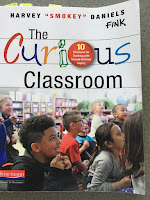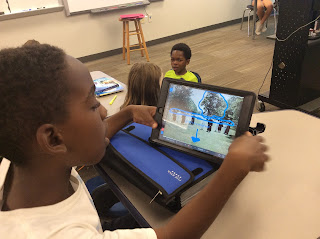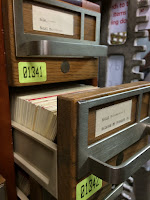I've committed this year to shift the focus in my class from the traditional historical figures to group/individual voices not typically heard within the American history narrative. I am anchoring my 5th grade American history curriculum with the theme connected to identity, labels, and power. With each unit from American Indians, slavery, colonization, American Revolution, Civil Rights the theme is designed to reveal different perspectives other than the typical dominate side.
We spent the first three weeks of school engaged in an inquiry based project, "Is identity connected to power?" In the process, it was the perfect way for us to get to know each other on a deeper level and a great way to build a sense of community. The theme was first staged by showing a couple of Ancestry.com commercials. In small groups, students noted the emotions express by the individuals in the commercial as their Nigerian and American Indian ancestries were revealed. This led to discussions as to why the individuals reacted in the manner that they did.
 |
| https://www.youtube.com/watch?v=lexegLWPIHg |
 |
| https://www.youtube.com/watch?v=0l0_ttMidII |
We then shifted gears to exploring our own identities. I provided students with an identity social matrix I adapted from the Let's Get Real book by Caldwell & Oman. Each identity trait was then rated on the level of importance and how visible the trait was to others. I modeled filling out the matrix by sharing my own identity. Students began to realize that not all identity traits are visible to others. For instance, I am from Nicaraguan descent - which my students found surprising. Most did not know I was Latina.
When I had students fill out their own identity matrix, I was surprised how many students had never thought about their race. I knew I would have to clear up the difference between race and ethnicity, but had not planned for racial uncertainty among my students. I had to backtrack and help them unpack it. Some students wanted to put American for race instead of white. Next year, I will definitely create a more intentional way to help students understand the word race.
I had students select six words from their identity matrix and other core identity descriptors not on the matrix to create identity swirls. The art teacher came in to give students a quick mini lesson on creating funky fonts and brought in a huge assortment of cool markers and gel pens. Students worked on their swirls for two class periods. Once completed, they uploaded the swirl to Seesaw (digital portfolio) and wrote a reflection.
 |
| Creating Identity Swirls |
On day four, we moved to the next supporting question: How are we labeled by others/society? We started off by discussing how our bedrooms typically have identity clues everywhere. Students shared what we would see in their rooms would definitely reveal part of their identity. One student suggested that it would be interesting for them to bring in a photo of their own rooms to share. Not a bad idea!
Then, I printed out images from the book Where Children Sleep by James Mollison. First with the whole class, I modeled the see-think-wonder thinking routine with a bedroom image that was full of identity conflicting evidence. Students were all over the place labeling who slept in the room. When I finally revealed the photo of the child with long hair, they assumed it was a girl. Then I started to read the short bio. When I read "he" they all screamed, "What?!" One by one, we eliminated the inaccurate labels they had recorded.
In small groups, students analyzed other bedrooms. The small groups presented their bedroom images to the class and shared their perceived labels. I then revealed the owner's photo and read the bio, again noticing how frequently labels were misrepresented. We discussed how hurtful and damaging labels can be too. Students were asked to spend the rest of the day detecting labels thrown their way by teachers, parents, siblings, friends, etc. They were asked to bring at least six labels and an object that made them feel powerful to class the next day.
 |
| See-Think-Wonder thinking routine with bedroom image. |
 |
| Bedroom Image |
 |
| Owner of Bedroom |
Day five: Where do we hold power in our lives? was the third and last supporting question. Our school counselor came in to do a lesson on power. Students brought to class an object or image that represented where they felt powerful. Some examples of objects were: pencils, swimsuit, chess playbook, sculpture, martial arts belt, etc. Students then had to think of a "power word" that the object made them feel like creative, expressive, bold, etc. In small groups, students shared their power object and word. Then, they were asked to create a tableau - human sculpture - that incorporated their words. The rest of the class did a gallery walk and tried to guess their powers.
 |
| Sharing Power Object |
 |
| Power Group Tableau |
The take away was everyone holds power in their lives no matter what their gender, race, age, etc. When harmful labels are used, we are all empowered in different ways to interrupt these labels. For next year, I need to make sure to circle back to the compelling question!
Day six and seven were spent on a booklet that tied everything together. Again, the art teacher came in to get students started on the final project. Overall, I found this project to be a powerful way to start the year and set the stage for more to come.
Booklet Covers
 |
Identity Collage - students had the choice to draw or use PicCollage app to print out images that represented their own identity.
 |
 |
Labels - Student used different labels, stamps and wrote labels that people give them.

Power Object & Word - Students drew or printed out an image of their object and wrote their power word.
Display in hallway.
 |




































